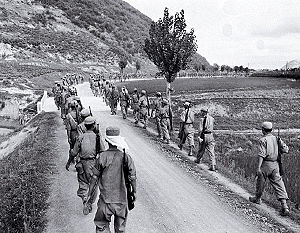| Battle of P'ohang-dong | |||||||
|---|---|---|---|---|---|---|---|
| Part of the Battle of Pusan Perimeter | |||||||
 South Korean troops march toward the front lines of the Pusan Perimeter | |||||||
| |||||||
| Belligerents | |||||||
|
| |||||||
| Commanders and leaders | |||||||
|
|
| ||||||
| Strength | |||||||
| 58,000 (est.) | 21,500 (est.) | ||||||
| Casualties and losses | |||||||
|
~3800 killed 181 captured | |||||||
The Battle of P'ohang-dong was an engagement between the United Nations Command (UN) and North Korean forces early in the Korean War, with fighting continuing from 5–20 August 1950 around the town of P'ohang-dong, South Korea. It was a part of the Battle of Pusan Perimeter, and was one of several large engagements fought simultaneously. The battle ended in a victory for the UN after their forces were able to drive off an attempted offensive by three North Korean Korean People's Army (KPA) divisions in the mountainous eastern coast of the country.
Forces of the South Korean Republic of Korea Army (ROKA), supported by the United States Navy and United States Air Force (USAF), defended the eastern coast of the country as a part of the Pusan Perimeter. When several divisions of the KPA crossed through mountainous terrain to push the UN forces back, a complicated battle ensued in the rugged terrain around P'ohang-dong, which contained the vital supply line to the main UN force at Taegu.
For two weeks KPA and ROK units fought in several bloody back-and-forth battles, taking and retaking ground in which neither side was able to gain the upper hand. Finally, following the breakdown of the KPA supply lines and amidst mounting casualties, the exhausted North Korean troops were forced to retreat.
The battle was a turning point in the war for KPA forces, which had seen previous victories owing to superior numbers and equipment, but the distances and demands exacted on them at P'ohang-dong rendered their supply lines untenable.